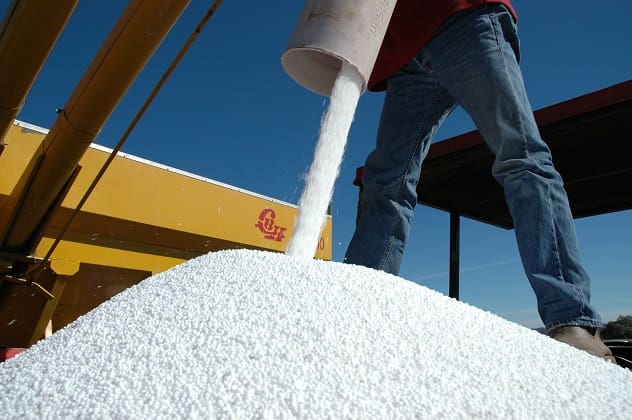
DPIRD researchers say deferring nitrogen decisions until later in the season can allow growers to make better decisions about nitrogen application rates for cereal crops. (Photo: GRDC)
WESTERN Australian grain growers considering the nutritional requirements of wheat and barley crops following recent rainfall are advised nitrogen (N) fertiliser applied relatively late in the season can often achieve optimum results for both grain yields and protein levels.
Department of Primary Industries and Regional Development (DPIRD) research officer Dion Nicol has led the ‘Tactical Nitrogen’ component of the ‘Tactical Wheat Agronomy for the West’ project, conducted by DPIRD with Grains Research and Development Corporation (GRDC) investment.
The wheat trials were conducted in 2016 and 2017 at Mingenew, Wongan Hills, Grass Patch and Lake Grace. Five trials are underway in 2018 in similar locations, with the addition of Merredin.
Dr Nicol said the research showed that generally there was no wheat crop yield penalty when N was applied later in the season – right up to just prior to the flag emergence stage – compared with applications of the same rates of N made earlier in the season.
“Some wheat crops in the trials actually yielded more from later applications of N, which may have been due to more leaching of this nutrient from earlier applications,” he said.
“However, the later N applications in these trials have often had the added advantage of improving wheat grain protein levels at harvest time.”
Dr Nicol said a 2017 experiment at Wongan Hills – looking at the influence of N timing across different wheat sowing times and variations in crop maturity – resulted in a flat yield response across the treatments but protein levels increased as N applications were delayed.
“In that trial, N applied 12 weeks after sowing – with no N applied earlier in the season including no ‘starter N’ – achieved the optimum yield but with an additional 1.5 per cent protein when compared with the same N rate (50 kilograms/hectare) applied at seeding time,” he said.
“Overall, optimum results for both wheat crop yields and protein levels across the trial sites were achieved from N applications made from the end of plant tillering to the start of stem elongation.”
“The trial results help demonstrate that if you have a N deficient crop right now, you can successfully address that deficiency by applying N fertiliser even up to mid-August, moisture permitting.”
Dr Nicol said the degree of crop stress caused by nitrogen deficiency – and corresponding potential yield losses – was determined by a paddock’s N status and the crop’s yield potential based on seasonal conditions.
“Choosing the optimum N fertiliser rate can be challenging because requirements are driven by the supply of N in the soil and yield potential based on seasonal conditions, which can be difficult to assess,” he said.
“Deferring N decisions until later in the season can allow growers to make better decisions about N application rates because they will then know more about the season and can better assess the status of the crop and respond to nutrient losses from waterlogging or leaching.”
DPIRD research officer Blakely Paynter said a similar impact of N timing on crop yield and protein levels had been found in barley through trials conducted in the ‘Management of barley and barley cultivars in Western Australia’ project, a research partnership between DPIRD and GRDC.
The barley research to date has focused on the benefits of N application at stem elongation. Barley trials underway in 2018 at Yerecoin, Brookton, Kojonup and Wittenoom Hills are looking more closely at the post-stem elongation period to see if crop responses mirror those observed in wheat.
Source: GRDC
For more information about the influence of N timing on grain protein management in barley see the GRDC GroundCover article ‘Research Prompts Nitrogen Rethink for Barley’ available at http://bit.ly/2Ko3K9A or go to http://bit.ly/2KmOUjR
For information about optimising N application in-season, go to http://bit.ly/2LQwk9h
Grain Central: Get our free daily cropping news straight to your inbox – Click here

HAVE YOUR SAY